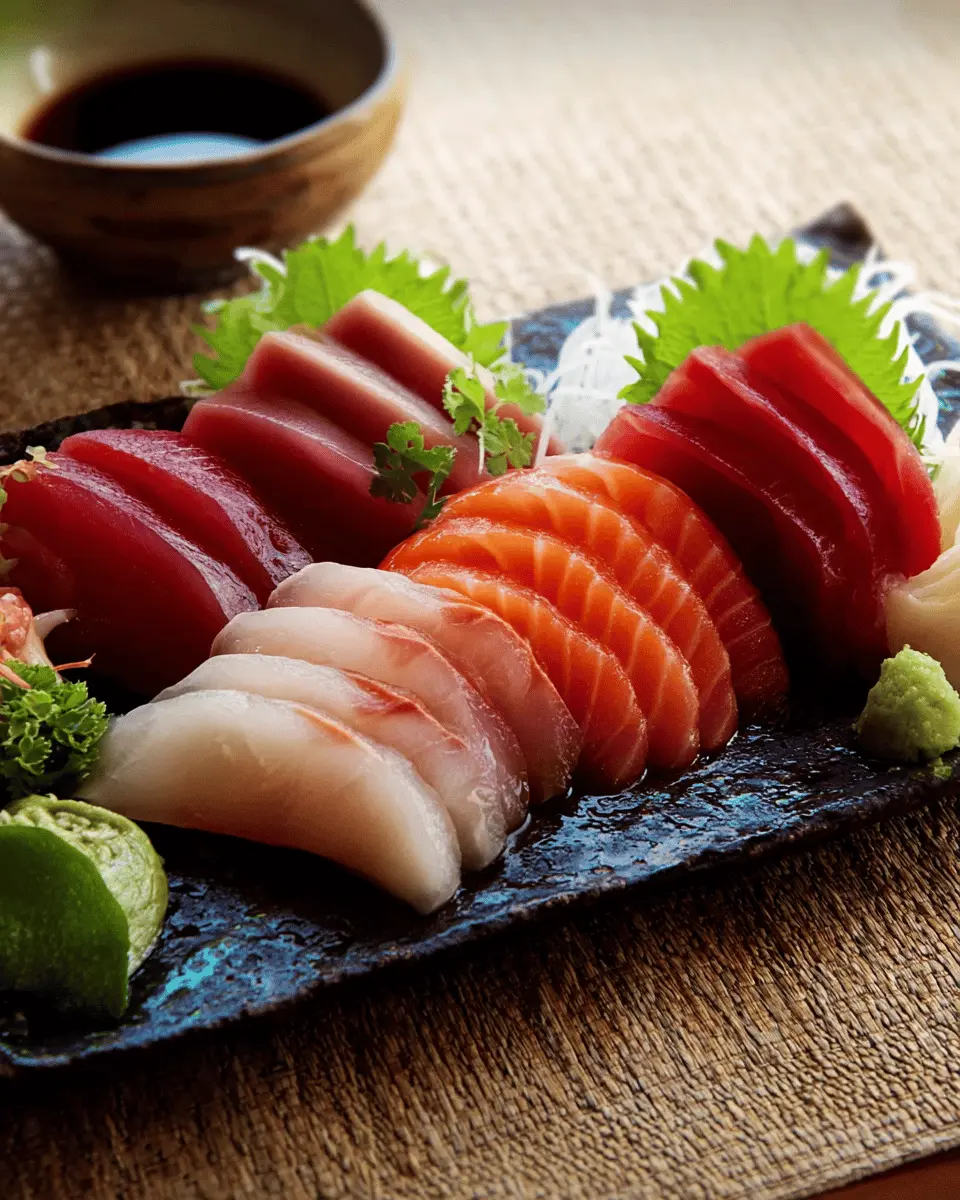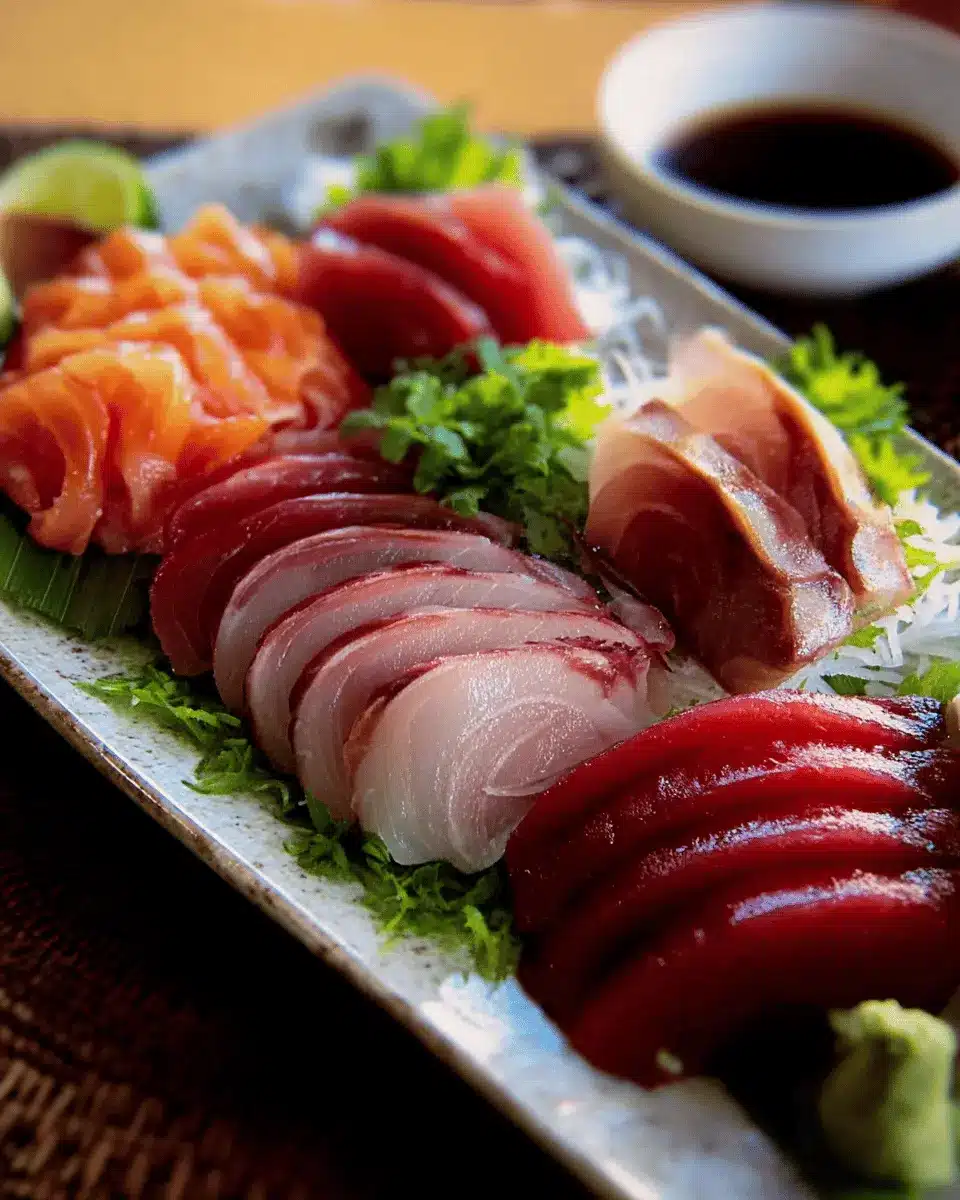Introduction to Sashimi Recipe
Why Enjoy Sashimi?
Sashimi is not just a dish; it's an art form that celebrates the purity of fresh fish. Traditionally served raw and sliced into thin pieces, it allows the natural flavors and textures of quality seafood to shine. Whether you’re a sushi aficionado or a newcomer, preparing a homemade sashimi recipe can be a delightful culinary adventure. Not to mention, enjoying sashimi is a healthier option packed with protein and omega-3 fatty acids, making it a nourishing choice for any meal.
A Brief History and the Appeal of Homemade Sashimi
The origins of sashimi date back to Japan, where it was initially enjoyed by the elite. Over time, it has evolved into a beloved dish worldwide, appreciated for its simplicity and elegance. Making sashimi at home not only gives you full control over the ingredients, allowing you to select high-quality, sashimi-grade fish, but it also provides a unique dining experience. Imagine slicing your fish with precision and placing it beautifully on a plate. It’s a rewarding process that connects you to culinary traditions while providing an incredible feast for the senses. For more inspiration and tips on preparing sashimi, sources like Serious Eats offer great insights to help you perfect your technique.
So, are you ready to dive into the art of sashimi and impress your friends and family with your new skills?

Ingredients for Sashimi
Essential Ingredients for the Perfect Sashimi
Creating an authentic sashimi recipe starts with the right ingredients. To truly experience this dish, you need:
- Daikon radish: This crunchy vegetable not only adds texture but also serves as a refreshing palate cleanser.
- Sashimi grade fish: Opt for top-quality tuna, yellowtail, and salmon. Each fish brings its own unique flavor and texture.
- Shiso leaves: These aromatic leaves enhance the dish, complementing the fish beautifully.
- Wasabi: A little heat goes a long way in bringing out the flavors of your sashimi.
- Soy sauce: A staple condiment that ties all the components together.
The Importance of Choosing Quality Sashimi Grade Fish
When selecting fish for sashimi, quality is non-negotiable. Sashimi grade fish is caught and handled with utmost care to ensure it’s safe for raw consumption. According to the USDA, fish labeled as sashimi grade meets specific safety standards. Using fresh, high-quality fish not only enhances the taste but also minimizes health risks. Always source your fish from reputable suppliers or local markets. When in doubt, don’t hesitate to ask your fishmonger for recommendations. Enjoy your culinary adventure!
Step-by-step Preparation of Sashimi
Creating a delicious sashimi dish at home can seem intimidating at first, but with the right guidance, it can be quite an enjoyable culinary adventure. Let’s walk through the process together, breaking it down into easy, manageable steps.
Preparing the Daikon Radish
Start with the daikon radish, a staple in many sashimi recipes. First, remove the skin and slice it thinly using a mandolin or a sharp knife. Aim for paper-thin slices, as this will help create that lovely, delicate crunch that complements the sashimi beautifully.
Once you’ve sliced the daikon, stack 3-4 layers and julienne them very thinly. This technique not only enhances presentation but also adds an elegant texture to your dish. To ensure a refreshing crunch, soak the julienned daikon in cold water for about 15 minutes. This step hydrates the radish and makes it crispier. After soaking, strain the daikon and pat it dry to remove excess moisture.
Slicing the Sashimi-Grade Fish
Next up is the fish! Choosing high-quality sashimi-grade fish is crucial for safety and flavor. You can use tuna, yellowtail, and salmon, as listed in our basic recipe. For slicing, a very sharp knife is essential. If you can, use a sushi knife or a chef's knife.
- For tuna and yellowtail, slice into ¼" to ⅓" thick pieces. It’s best to cut against the grain for a tender bite.
- For salmon, angle your knife slightly and slice thinly.
Practicing your slicing skills can be a rewarding experience, so take your time and enjoy the process. If you're interested in learning more about fish slicing techniques, check out resources such as Serious Eats.
Plating the Sashimi
Now that you've perfectly sliced your fish, it’s time to make the dish visually appealing. On a clean plate, create a beautiful layout by arranging the fish slices harmoniously. Add the julienned daikon radish alongside the fish, and place shiso leaves artistically around the plate. The bright green of the shiso not only adds color but also a unique aromatic flavor.
Remember, presentation is key! Feel free to get creative—sometimes, less is more.
Serving with Accompaniments
Finally, serve your sashimi with accompaniments for dipping. Offer wasabi and soy sauce in small bowls. For added authenticity, consider using a traditional Japanese sake, or substitute with a refreshing iced green tea for a delightful pairing.
Your homemade sashimi is now ready to be enjoyed! Invite friends over to share in the culinary experience or savor it solo—it’s all about enjoying the moment.
With this step-by-step guide, you’re well on your way to mastering your very own sashimi recipe. Happy cooking!

Variations on Sashimi
Sashimi with Different Types of Fish
While traditional sashimi often features tuna, yellowtail, and salmon, there’s a delightful world of flavors waiting to be explored. You can try mackerel for its rich, fatty texture or opt for lighter fishes like snapper or flounder. Don’t hesitate to experiment with local catches—sashimi is incredibly versatile, allowing you to tailor your experience with what’s fresh and available.
Vegetarian Sashimi Alternatives
If you’re leaning toward plant-based options, vegetarian sashimi can be a game changer. Thinly sliced avocado and cucumber provide a creamy and refreshing bite, while tomatoes can mimic the texture of fish. Consider marinated carrots or beetroot for added color and depth. These alternatives not only expand your sashimi repertoire but also cater to various dietary preferences. For more ideas on creating a beautiful vegetarian platter, check out this vegetarian sushi guide.
Cooking Tips and Notes for Sashimi
Choosing the Right Tools for Preparation
When preparing your sashimi recipe, having the right tools can make all the difference. Invest in a sharp chef's knife, as a clean cut is crucial for preserving the texture and flavor of the fish. A sturdy cutting board is essential as well—preferably wood or bamboo, which are gentle on your knife's edge. If you can, using a mandolin slicer for the daikon radish ensures uniform thin slices that enhance the dish's presentation.
How to Store Sashimi Ingredients Properly
To maintain freshness, store sashimi-grade fish in the coldest part of your refrigerator, ideally at 32°F (0°C). Keep it wrapped tightly in plastic wrap or in an airtight container, ideally on a bed of ice. For daikon and shiso leaves, keep them in the crisper drawer of your fridge, wrapped in a damp paper towel to retain moisture. Proper storage will keep everything fresh until you’re ready to impress your guests with this delightful sashimi recipe! For more tips on seafood storage, check out resources from the Seafood Health Facts.

Serving Suggestions for Sashimi
Ideal Pairings with Sashimi
When enjoying your sashimi recipe, consider enhancing the experience with complementary flavors and textures. Pair your sashimi with:
- Refreshing Drinks: Iced green tea or sparkling water add a refreshing touch.
- Condiments: Beyond soy sauce and wasabi, try pickled ginger for a palate cleanser.
- Side Dishes: A light miso soup or a simple seaweed salad makes for a fantastic accompaniment.
Aesthetic Plating Ideas to Impress Guests
Presentation is key! Impress your guests with these plating ideas:
- Layering: Arrange slices of sashimi artistically on a bed of julienned daikon for a stunning visual.
- Color Contrast: Use colorful shiso leaves to create a vibrant display.
- Minimalist Approach: Keep it simple by using a clean white plate, allowing the vibrant colors of the fish to shine.
These ideas will not only elevate the dining experience but also leave your guests raving about your culinary skills! For more inspiration, check out this helpful guide on plating techniques.
Time Breakdown for Sashimi Preparation
Preparation Time
Getting everything ready for your sashimi recipe takes about 30 minutes. This includes slicing the fish and preparing the daikon radish for that perfect crunch.
Total Time
In total, you’ll need about 30 minutes to have your delicious sashimi ready to serve. It's a quick and impressive dish for any gathering!
For more tips on enhancing your sashimi experience or exploring other seafood options, check out this comprehensive guide on seafood preparation. Who knew such a simple dish could make you feel like a gourmet chef? Enjoy the process!
Sashimi Recipe
Prep Time 30 minutes
Servings 4
Ingredients
- Daikon radish (about 4" (10 cm))
- Tuna (Sashimi grade, block)
- Yellowtail (Sashimi grade, fillet)
- Salmon (Sashimi grade, block)
- Shiso leaves
- Wasabi
- Soy Sauce
Instructions
- Remove skin of Daikon radish. Slice thinly with a mandolin or slicer. Stack 3-4 layers of thin Daikon, and julienne very thinly. Put it in a bowl of water and leave for 15 minutes to make it crispy. Strain and remove moisture.
- Slice tuna and yellowtail into ¼"-⅓" thick (6 mm-8 mm) pieces. Slice salmon thinly at a slight angle.
- Serve sashimi on a plate with radish, Shiso leaves, and Wasabi along with Soy Sauce for dipping.
Nutritional Facts for Sashimi
Calories
Sashimi is a low-calorie choice, making it perfect for those watching their diet. A typical serving contains about 100-150 calories, depending on the fish varieties used.
Protein Content
You'll find sashimi packed with protein! A single serving can provide 20-30 grams of protein, supporting muscle repair and growth. Not to mention, it's a great alternative to traditional protein sources like chicken or beef.
Omega-3 Fatty Acids
Packed with heart-healthy omega-3 fatty acids, sashimi helps reduce inflammation and supports brain health. A serving typically includes a generous amount of these beneficial fats, making it an ideal choice for health-conscious eaters.
By enjoying your sashimi recipe, you’re not just diving into delightful flavors but also nourishing your body. If you’re curious about other health benefits or preparation tips, feel free to check out sources like the American Heart Association for more insights on seafood nutrition!
FAQs about Sashimi
Can I make Sashimi without special knives?
Absolutely! While traditional sashimi knives, like a yanagiba, offer precision, a sharp chef's knife can do the trick. The key is to ensure it's sharp, as dull knives can ruin the delicate texture of the fish. If you're cutting thin slices, gentle, smooth motions will yield the best results.
What are the best fish for Sashimi?
For your sashimi recipe, popular choices include:
- Tuna: Especially bluefin or yellowfin.
- Salmon: Look for fresh, fatty cuts.
- Yellowtail: A delicious option with rich flavor.
Other seafood like mackerel or octopus can also be delightful!
How to tell if fish is Sashimi grade?
Look for freshness! The flesh should be bright and shiny, with a pleasant sea aroma. An easy tip is to check for clear eyes and red gills. Sashimi-grade fish must be frozen at -4°F (-20°C) for at least seven days to kill parasites. Always seek fish from reputable sources; consider checking resources like the Monterey Bay Seafood Watch for sustainable options.
Conclusion on Sashimi Recipe
The joy of savoring homemade Sashimi and encouragement to try it!
Making your own sashimi at home can be an exciting culinary adventure. There's something truly joyful about preparing and savoring fresh, high-quality fish right in your kitchen. So why not give this sashimi recipe a try? You might just discover a new favorite dish along the way!
For tips on selecting the freshest fish, check out resources from Seafood Watch to ensure sustainability while enjoying your meal. Happy cooking!

Sashimi Recipe
Equipment
- mandolin
- slicer
Ingredients
Seafood and Accompaniments
- 1 piece Daikon radish (about 4" (10 cm))
- 200 grams tuna (Sashimi grade, block)
- 200 grams yellowtail (Sashimi grade, fillet)
- 200 grams salmon (Sashimi grade, block)
- a few Shiso leaves
- as needed Wasabi
- as needed Soy Sauce
Instructions
Preparation
- Remove skin of Daikon radish. Slice thinly with a mandolin or slicer. Stack 3-4 layers of thin Daikon, and julienne very thinly. Put it in a bowl of water and leave for 15 minutes to make it crispy. Strain and remove moisture.
- Slice tuna and yellowtail into ¼"-⅓" thick (6 mm-8 mm) pieces. Slice salmon thinly at a slight angle.
- Serve Sashimi on a plate with radish, Shiso leaves, and Wasabi along with Soy Sauce for dipping.




Leave a Reply